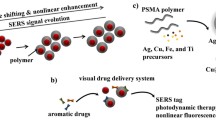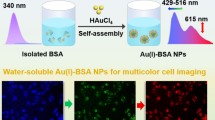Abstract
Special attention has been paid to the organic afterglow materials (OAM) for their fascinating properties. However, poor stability at air and complicated structure design hinder the development of OAM. Herein, sol-gel, a facile and simple technique, is employed to synthesize a series of organic/inorganic hybrid nanocomposites (N1/SiO2, N2/SiO2, and N3/SiO2) by covalently linking three common aryl imides with crosslinked silica skeleton. These nanomaterials show excitation wavelength-dependent and colorful (yellow, red and green) afterglow of organic imides with long lifetime up to 1.1 s at air. Interestingly, the ultralong phosphorescence is ultrastable under various conditions: water, high temperature, UV irradiation and in vivo, due to the protection of inorganic silica. In particularly, heating to 500 °C does not quench the afterglow of organic luminophore in nanocomposites, but forms new ultralong phosphorescence originated from space-conjugation of silica and carbonyl. The afterglow nanomaterials display huge advantages in the applications of advanced anti-counterfeiting and bioimaging.

Similar content being viewed by others
References
Yang, S. M.; Wu, D. B.; Gong, W. J.; Huang, Q. Q.; Zhen, H. Y.; Ling, Q. D.; Lin, Z. H. Highly efficient room-temperature phosphorescence and afterglow luminescence from common organic fluorophores in 2D hybrid perovskites. Chem. Sci.. 2018, 9, 8975–8981.
Kenry; Chen, C. J.; Liu, B. Enhancing the performance of pure organic room-temperature phosphorescent luminophores. Nat. Commun.. 2019, 10, 2111.
Xu, S.; Chen, R. F.; Zheng, C.; Huang, W. Excited state modulation for organic afterglow: Materials and applications. Adv. Mater.. 2016, 28, 9920–9940.
Miao, Q. Q.; Xie, C.; Zhen, X.; Lyu, Y.; Duan, H. W.; Liu, X. G.; Jokerst, J. V.; Pu, K. Y. Molecular afterglow imaging with bright, biodegradable polymer nanoparticles. Nat. Biotechnol.. 2017, 35, 1102–1110.
Maldiney, T.; Lecointre, A.; Viana, B.; Bessière, A.; Bessodes, M.; Gourier, D.; Richard, C.; Scherman, D. Controlling electron trap depth to enhance optical properties of persistent luminescence nanoparticles for in vivo imaging. J. Am. Chem. Soc.. 2011, 133, 11810–11815.
Lehner, P.; Staudinger, C.; Borisov, S. M.; Klimant, I. Ultra-sensitive optical oxygen sensors for characterization of nearly anoxic systems. Nat. Commun.. 2014, 5, 4460.
Mathew, A. S.; DeRosa, C. A.; Demas, J. N.; Fraser, C. L. Difluoroboron ß-diketonate materials with long-lived phosphorescence enable lifetime based oxygen imaging with a portable cost effective camera. Anal. Methods2016, 8, 3109–3114.
Kabe, R.; Notsuka, N.; Yoshida, K.; Adachi, C. Afterglow organic light-emitting diode. Adv. Mater.. 2016, 28, 655–660.
Huang, Q. Q.; Mei, X. F.; Xie, Z. L.; Wu, D. B.; Yang, S. M.; Gong, W. J.; Chi, Z. G.; Lin, Z. H.; Ling, Q. D. Photo-induced both phosphorescence and mechanoluminescence switch from a simple purely organic molecule. J. Mater. Chem. C2019, 7, 2530–2534.
Su, Y.; Phua, S. Z. F.; Li, Y. B.; Zhou, X. J.; Jana, D.; Liu, G. F.; Lim, W. Q.; Ong, W. K.; Yang, C. L.; Zhao, Y. L. Ultralong room temperature phosphorescence from amorphous organic materials toward confidential information encryption and decryption. Sci. Adv.. 2018, 4, eaas9732.
Yang, S. M.; Zhou, B.; Huang, Q. Q.; Wang, S. Q.; Zhen, H. Y.; Yan, D. P.; Lin, Z. H.; Ling, Q. D. Highly efficient organic afterglow from a 2D layered lead-free metal halide in both crystals and thin films under an air atmosphere. ACS Appl. Mater. Interfaces2020, 12, 1419–1426.
Li, H.; Ye, S.; Guo, J. Q.; Kong, J. T.; Song, J.; Kang, Z. H.; Qu, J. L. The design of room-temperature-phosphorescent carbon dots and their application as a security ink. J. Mater. Chem. C2019, 7, 10605–10612.
Fateminia, S. M. A.; Mao, Z.; Xu, S. D.; Yang, Z. Y.; Chi, Z. G.; Liu, B. Organic nanocrystals with bright red persistent room-temperature phosphorescence for biological applications. Angew. Chem., Int. Ed.. 2017, 56, 12160–12164.
Shi, H. F.; Song, L. L.; Ma, H. L.; Sun, C.; Huang, K. W.; Lv, A. Q.; Ye, W. P.; Wang, H.; Cai, S. Z.; Yao, W. et al. Highly efficient ultralong organic phosphorescence through intramolecular-space heavy-atom effect. J. Phys. Chem. Lett.. 2019, 10, 595–600.
Gong, Y. Y.; Chen, G.; Peng, Q.; Yuan, W. Z.; Xie, Y. J.; Li, S. H.; Zhang, Y. M.; Tang, B. Z. Achieving persistent room temperature phosphorescence and remarkable mechanochromism from pure organic luminogens. Adv. Mater.. 2015, 27, 6195–6201.
Gao, R.; Yan, D. P. Layered host–guest long-afterglow ultrathin nanosheets: High-efficiency phosphorescence energy transfer at 2D confined interface. Chem. Sci.. 2017, 8, 590–599.
Hirata, S.; Totani, K.; Zhang, J. X.; Yamashita, T.; Kaji, H.; Marder, S. R.; Watanabe, T.; Adachi, C. Efficient persistent room temperature phosphorescence in organic amorphous materials under ambient conditions. Adv. Funct. Mater.. 2013, 23, 3386–3397.
Kabe, R.; Adachi, C. Organic long persistent luminescence. Nature2017, 550, 384–387.
Ogoshi, T.; Tsuchida, H.; Kakuta, T.; Yamagishi, T. A.; Taema, A.; Ono, T.; Sugimoto, M.; Mizuno, M. Ultralong room-temperature phosphorescence from amorphous polymer poly (styrene sulfonic acid) in air in the dry solid state. Adv. Funct. Mater.. 2018, 28, 1707369.
Yuan, J.; Wang, S.; Ji, Y.; Chen, R. F.; Zhu, Q.; Wang, Y. R.; Zheng, C.; Tao, Y.; Fan, Q.; Huang, W. Invoking ultralong room temperature phosphorescence of purely organic compounds through H-aggregation engineering. Mater. Horiz.. 2019, 6, 1259–1264.
Liu, J. B.; Zhuang, Y. X.; Wang, L.; Zhou, T. L.; Hirosaki, N.; Xie, R. J. Achieving multicolor long-lived luminescence in dye-encapsulated metal-organic frameworks and its application to anticounterfeiting stamps. ACS Appl. Mater. Interfaces2018, 10, 1802–1809.
Yang, X.; Yan, D. Long-afterglow metal–organic frameworks: Reversible guest-induced phosphorescence tunability. Chem. Sci.. 2016, 7, 4519–4526.
Li, Q. J.; Zhou, M.; Yang, M. Y.; Yang, Q. F.; Zhang, Z. X.; Shi, J. Induction of long-lived room temperature phosphorescence of carbon dots by water in hydrogen-bonded matrices. Nat. Commun.. 2018, 9, 734.
Jiang, Y. Y.; Huang, J. G.; Zhen, X.; Zeng, Z. L.; Li, J. C.; Xie, C.; Miao, Q. Q.; Chen, J.; Chen, P.; Pu, K. Y. A generic approach towards afterglow luminescent nanoparticles for ultrasensitive in vivo imaging. Nat. Commun.. 2019, 10, 2064.
Tian, S.; Ma, H. L.; Wang, X.; Lv, A. Q.; Shi, H. F.; Geng, Y.; Li, J.; Liang, F. S.; Su, Z. M.; An, Z. F. et al. Utilizing d–pp bonds for ultralong organic phosphorescence. Angew. Chem., Int. Ed.. 2019, 58, 6645–6649.
Tian, D.; Zhu, Z. C.; Xu, L.; Cong, H. J.; Zhu, J. T. Intramolecular electronic coupling for persistent room-temperature luminescence for smartphone based time-gated fingerprints detection. Mater. Horiz.. 2019, 6, 1215–1221.
Yuan, J.; Chen, R. F.; Tang, X. X.; Tao, Y.; Xu, S.; Jin, L.; Chen, C. L.; Zhou, X. H.; Zheng, C.; Huang, W. Direct population of triplet excited states through singlet–triplet transition for visible-light excitable organic afterglow. Chem. Sci.. 2019, 10, 5031–5038.
Wang, C. R.; Gong, Y. Y.; Yuan, W. Z.; Zhang, Y. M. Crystallizationinduced phosphorescence of pure organic luminogens. Chin. Chem. Lett.. 2016, 27, 1184–1192.
Chen, H.; Yao, X. Y.; Ma, X.; Tian, H. Amorphous, efficient, roomtemperature phosphorescent metal-free polymers and their applications as encryption ink. Adv. Opt. Mater.. 2016, 4, 1397–1401.
Ma, X.; Xu, C.; Wang, J.; Tian, H. Amorphous pure organic polymers for heavy-atom-free efficient room-temperature phosphorescence emission. Angew. Chem., Int. Ed.. 2018, 57, 10854–10858.
Lin, Z. H.; Zheng, X.; Chen, H.; Ling, Q. D.; Chen, Q. S.; Zhao, C. X. A new kind of porous hybridized nanocomposite: ω-sulfonicperfluoroalkylated polyalkoxysilane/silica. J. Porous Mater.. 2013, 20, 851–858.
Lin, Z. H.; Huang, L. M.; Ling, Q. D.; Chen, H.; Zhao C. X. ω-Sulfonic-perfluoroalkylated poly (styrene–maleic anhydride)/silica hybridized nanocomposite as a new kind of solid acid catalyst. J. Mol. Catal. A Chem.. 2012, 365, 73–79.
Aparicio, M.; Jitianu, A.; Klein, L. C. Sol-Gel Processing for Conventional and Alternative Energy; Springer: New York, 2012.
Song, M. R.; Song, J. L.; Ning, A. M.; Cui, B. A.; Cui, S. M.; Zhou, Y. B.; An, W. K.; Dong, X. S.; Zhang, G. G. Feasibility study of silica sol as the carrier of a hydrophobic drug in aqueous solution using enrofloxacin as the model. Mater. Sci. Eng. C2010, 30, 58–61.
Kalapathy, U.; Proctor, A.; Shultz, J. A simple method for production of pure silica from rice hull ash. Bioresour. Technol.. 2000, 73, 257–262.
Feng, Y. B.; Bai, T.; Yan, H. X.; Ding, F.; Bai, L. H.; Feng, W. X. High fluorescence quantum yield based on the through-space conjugation of hyperbranched polysiloxane. Macromolecules2019, 52, 3075–3082.
Ni, X.; Zhang, X. Y.; Duan, X. C.; Zheng, H. L.; Xue, X. S.; Ding, D. Near-infrared afterglow luminescent aggregation-induced emission dots with ultrahigh tumor-to-liver signal ratio for promoted imageguided cancer surgery. Nano Lett.. 2019, 19, 318–330.
Chen, C.; Ni, X.; Jia, S. R.; Liang, Y.; Wu, X. L.; Kong, D. L.; Ding, D. Massively evoking immunogenic cell death by focused mitochondrial oxidative stress using an AIE luminogen with a twisted molecular structure. Adv. Mater.. 2019, 31, 1904914.
Chen, C.; Ou, H. L.; Liu, R. H.; Ding, D. Regulating the photophysical property of organic/polymer optical agents for promoted cancer phototheranostics. Adv. Mater.2020, 32, 1806331.
Acknowledgements
This work was supported by the National Natural Science Foundation of China (Nos. 21374017, 21574021 and 51873092), and the Natural Science Foundation of Fujian Province (No. 2017J01684).
Author information
Authors and Affiliations
Corresponding authors
Electronic Supplementary Material
12274_2020_2740_MOESM1_ESM.pdf
Ultrastable and colorful afterglow from organic luminophores in amorphous nanocomposites: advanced anti-counterfeiting and in vivo imaging application
Rights and permissions
About this article
Cite this article
Huang, Q., Gao, H., Yang, S. et al. Ultrastable and colorful afterglow from organic luminophores in amorphous nanocomposites: advanced anti-counterfeiting and in vivo imaging application. Nano Res. 13, 1035–1043 (2020). https://doi.org/10.1007/s12274-020-2740-x
Received:
Revised:
Accepted:
Published:
Issue Date:
DOI: https://doi.org/10.1007/s12274-020-2740-x




